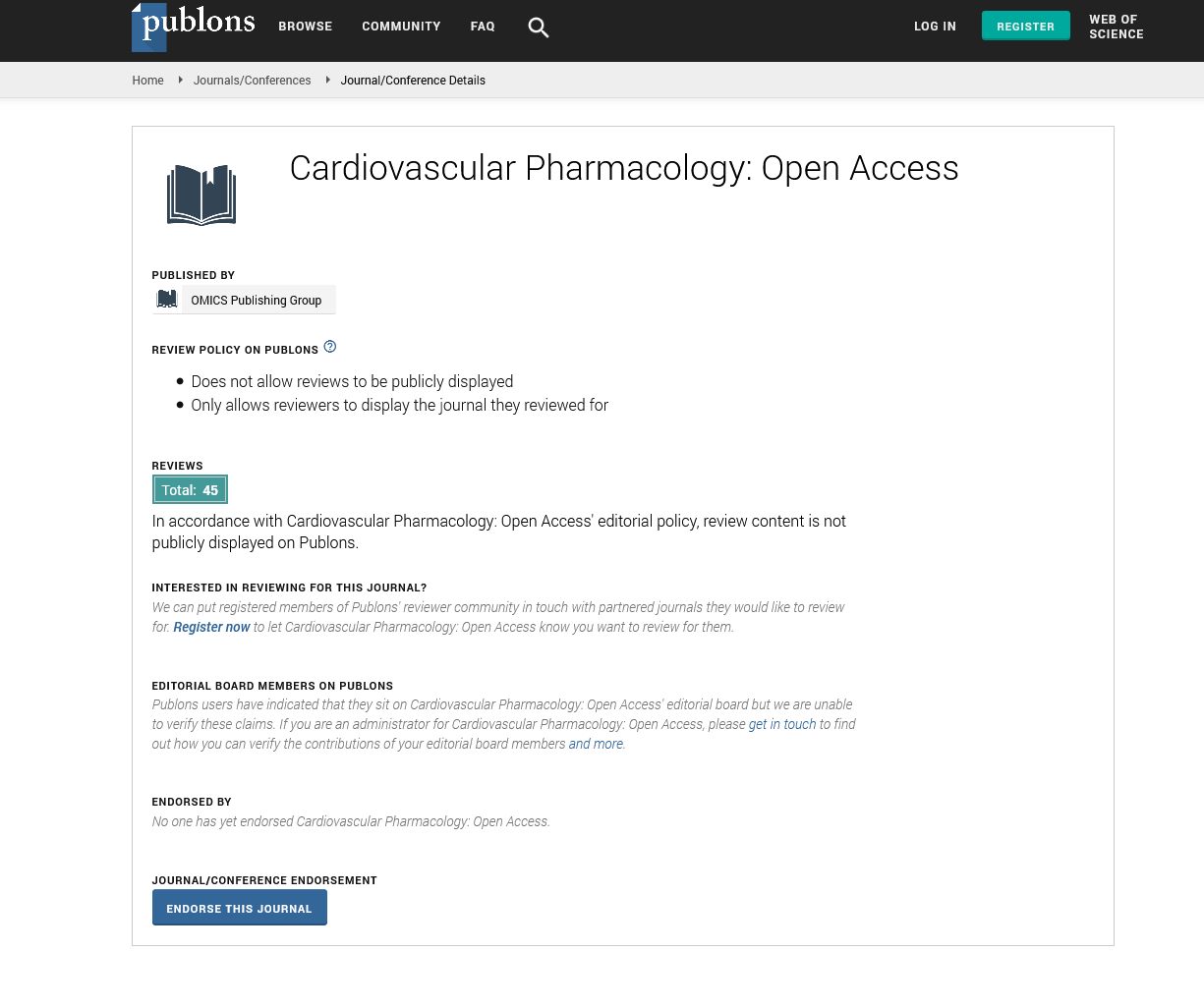Indexed In
- Open J Gate
- Cosmos IF
- RefSeek
- Hamdard University
- EBSCO A-Z
- OCLC- WorldCat
- Publons
- Geneva Foundation for Medical Education and Research
- Euro Pub
- Google Scholar
Useful Links
Share This Page
Journal Flyer

Open Access Journals
- Agri and Aquaculture
- Biochemistry
- Bioinformatics & Systems Biology
- Business & Management
- Chemistry
- Clinical Sciences
- Engineering
- Food & Nutrition
- General Science
- Genetics & Molecular Biology
- Immunology & Microbiology
- Medical Sciences
- Neuroscience & Psychology
- Nursing & Health Care
- Pharmaceutical Sciences
Perspective - (2024) Volume 13, Issue 3
Advances in Non-Valvular Atrial Fibrillation: From Epidemiology to Personalized Treatment Strategies
Emily Wong*Received: 30-Aug-2024, Manuscript No. CPO-24-27835; Editor assigned: 02-Sep-2024, Pre QC No. CPO-24-27835 (PQ); Reviewed: 16-Sep-2024, QC No. CPO-24-27835; Revised: 23-Sep-2024, Manuscript No. CPO-24-27835 (R); Published: 30-Sep-2024, DOI: 10.35248/2329-6607.24.13.404
Description
Atrial Fibrillation (AF) is one of the most prevalent arrhythmias, significantly influencing morbidity and mortality across diverse populations. Non-Valvular Atrial Fibrillation (NVAF) specifically refers to AF that occurs in the absence of rheumatic valvular disease, prosthetic heart valves, or a history of valvular surgery. The evolution of our understanding of NVAF has been marked by historical milestones, significant scientific contributions and clinical advancements that have shaped contemporary diagnosis, management and patient outcomes.
The differentiation between valvular and non-valvular forms of atrial fibrillation emerged more prominently in the later 20th century. The identification of risk factors that predispose individuals to NVAF increased the focus on preventative care. These factors include hypertension, diabetes, heart failure and advanced age. In particular, the Framingham Heart Study, initiated in 1948, provided critical insights into AF epidemiology, establishing a foundational understanding of its prevalence and risk associations. The study reinforced the idea that NVAF is largely linked to other cardiovascular conditions rather than valvular heart disease.
The clinical implications of NVAF are profound, particularly concerning the associated risk of stroke. The landmark research by Hart et al. in the late 1990s highlighted the elevated danger of thromboembolic events in NVAF patients. This prompted the development of stroke risk assessment tools, such as the CHA2DS2-VASc score, which aids clinicians in identifying suitable candidates for anticoagulation therapy. The evolution of anticoagulant therapy has been another critical facet of NVAF management. Warfarin, introduced in the 1950s, was the primary anticoagulant for decades, yet its limitations-such as the need for frequent monitoring and dietary restrictions-prompted the evaluation and eventual approval of Novel Oral Anticoagulants (NOACs) in the early 21st century. Drugs such as dabigatran, rivaroxaban, apixaban and edoxaban have simplified management and improved patient adherence.
Despite the advancements, NVAF presents several challenges and controversies. First, the diversity of the patient population makes management complex. Elderly patients often present with polypharmacy and comorbidities, raising concerns about drug interactions and the potential for adverse effects. Moreover, there is ongoing debate in the medical community about the optimal management of NVAF in patients at different risk levels and whether aggressive anticoagulation is warranted in all cases.
A critical negative aspect of NVAF management revolves around disparities in healthcare access and quality. Numerous studies have demonstrated that certain populations, including racial minorities and those from lower socioeconomic backgrounds, may not receive appropriate treatment for AF. Such inequalities can exacerbate outcomes, leading to an increased risk of stroke and related complications. As we advance, addressing these disparities through community engagement, education and policy changes is imperative for improving health equity.
An additional consideration in the discussion of NVAF is the psychological impact of living with a chronic arrhythmia. Patients with NVAF often experience anxiety and depression related to the unpredictability of their symptoms and lifestyle modifications. Mental health must be a component of holistic management, ensuring that patients not only receive physical healthcare but also psychological support.
In terms of research and future directions, the field of NVAF has seen a burgeoning interest in personalized medicine. As our understanding of genetic predispositions and biomarkers improves, future treatment strategies may become increasingly customized to the individual patient profile, providing more precise interventions. Innovations in technology and remote monitoring systems show potential in managing AF, potentially enhancing patient compliance and outcomes. The exploration of catheter ablation as a treatment for AF also represents an essential advancement, particularly for patients who are symptomatic despite anticoagulation.
In conclusion, the history and evolution of diagnosed non-valvular atrial fibrillation are characterized by significant contributions that have advanced our understanding and management. While there have been considerable strides in diagnosis and treatment, the challenges of healthcare disparities, individualized management and the psychological dimension of living with NVAF remain critical issues warranting further attention. Continuous research and innovation, along with a commitment to equitable healthcare, will be significant for improving outcomes across the diverse populations affected by this common arrhythmia.
Citation: Wong E (2024). Advances in Non-Valvular Atrial Fibrillation: From Epidemiology to Personalized Treatment Strategies. Cardiovasc Pharm. 13:404.
Copyright: © 2024 Wong E. This is an open access article distributed under the terms of the Creative Commons Attribution License, which permits unrestricted use, distribution and reproduction in any medium, provided the original author and source are credited.


